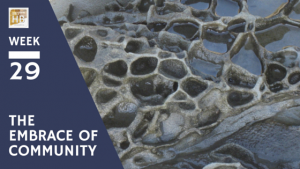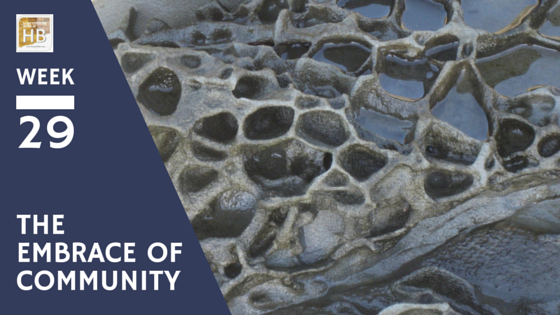Week 29 | Section 43
 This week we read of Jesus healing Peter’s mother-in-law and learn about the nature of community, compassion, and care. In this passage we see the compassion of Christ as the consolation of Jerusalem. Jesus’ attention to the Sabbath, care of the Peter’s mother-in-law and the others gathered provide us a worthy model that would transform cultures and communities around the globe.
This week we read of Jesus healing Peter’s mother-in-law and learn about the nature of community, compassion, and care. In this passage we see the compassion of Christ as the consolation of Jerusalem. Jesus’ attention to the Sabbath, care of the Peter’s mother-in-law and the others gathered provide us a worthy model that would transform cultures and communities around the globe.
Scripture:
[one_third last=”no”]Matthew 8:14-171
14 When Jesus came into Peter’s house,2 he saw his wife’s mother lying sick with a fever. 15 He touched her hand, and the fever left her. She got up and served him. 16 When evening came, they brought to him many possessed with demons. He cast out the spirits with a word, and healed all who were sick;3 17 that it might be fulfilled which was spoken through Isaiah the prophet, saying, “He took our infirmities, and bore our diseases.”4[/one_third]
[one_third last=”no”]Mark 1:29-34
29 Immediately, when they had come out of the synagogue, they came into the house of Simon and Andrew, with James and John. 30 Now Simon’s wife’s mother lay sick with a fever, and immediately they told him about her. 31 He came and took her by the hand, and raised her up. The fever left her, and she served them. 32 At evening, when the sun had set, they brought to him all who were sick, and those who were possessed by demons. 33 All the city was gathered together at the door. 34 He healed many who were sick with various diseases, and cast out many demons. He didn’t allow the demons to speak, because they knew him.[/one_third]
[one_third last=”yes”]Luke 4:38-41
38 He rose up from the synagogue, and entered into Simon’s house. Simon’s mother-in-law was afflicted with a great fever, and they begged him for her. 39 He stood over her, and rebuked the fever;5 and it left her. Immediately she rose up and served them. 40 When the sun was setting,6 all those who had any sick with various diseases brought them to him; and he laid his hands on every one of them, and healed them. 41 Demons also came out of many, crying out, and saying, “You are the Christ, the Son of God!” Rebuking them, he didn’t allow them to speak, because they knew that he was the Christ.[/one_third]
Group Dialog:
- Why do you think Matthew, Mark, and Luke include the story of Jesus healing Simon’s mother-in-law?
- What is different about the way Jesus handles this situation verses the demoniac earlier that day?
- Why did Jesus forbid the demons to speak of his nature.
- From this story, what can we extrapolate about Jesus’ attitude, priorities and character (humility, recognition, community, love, charity, etc.)? How does this compare to your own attitude, character, and priorities?
Learning Objectives:
community, compassion, and care, Jesus’ authority over illness,
Image: Close up of a large stone worn by the wind, waves, and pebbles at Bean Hollow State Park, CA. The image reminds us of unity, cell groups, and community.
Other media: Video clip of this passage; song: The Final Word, Michael Card
Study Notes:
- Notice that we’ve skipped over nearly four chapters of Matthew’s Gospel record. Matthew was writing to the Jews of his time and used a thematic approach rather than the chronological method which Mark used. Thomas and Gundry as well as other scholars allow Mark’s Gospel to establish most of chronology of Jesus life and ministry in the Harmony of the Gospels.
- The setting is in Peter’s mother in laws home, not a public place. This passage then provides some insight as to how the early church would live life together. It might also be interesting to note that we have no prior mention of Peter being married. There is no mention of the father-in-law or Peter’s wife. Clement of Alexandria (c. 150 – about 100 years later) does present that Peter had children and a wife. When Mark wrote his Gospel it was read by those who were contemporaries of Peter and the folks in Capernaum. We have the testimony of the two other Gospelers who also tell of this healing. Note also that they waited until evening came (at the close of the Sabbath) so as not to break the conventional law.
- Word about Jesus has spread and people were moved to go see Jesus and invite others to join them. As a result of their faith and action many more were healed. Now today we don’t hear much about healing throughout mainline churches – yet healing was not foreign or limited to Jesus time. Many had been healed before as seen in these passages: Numbers 12 a man is healed from leprosy; 1 Sam chapter 1 Hannah receives healing from barrenness; 2 Kings 13 and the bones of Elisha; 2 Kings 5 Naaman is told to wash seven times in the Jordan and be healed.
- Matthew uses the familiar passage of Isaiah 53, “the consolation of Israel” – read the entire passage to understand more of the messianic parallel to the life of Christ. In Jewish culture chapter 52 reveals that Israel is at a national low and then in chapter 54 the redemption of the nation of Israel is elaborated. So it is with us today, Those who are “laid low” will be “raised up” by grace through faith in Christ. The redemptive work is done and through our faith we experience the reality of the truth.
- Luke, the doctor, reports that Jesus rebuked the fever, laid his hand on her and she was healed. Peter’s mother-in-law resumes her intention to serve immediately after begin healed. Serving with an attitude of gratitude. In a word they were healed. In a Jewish sense the word is what brings life and Jesus is the Word. In the baptism of the Holy Spirit there are those who have been given this gift of healing and given the same authority. If we are in need today we can go to one of these folks or to Jesus himself and ask for healing and deliverance.
- The day began in section 42 (Mk 1:21-28 / Lk 4:31b-37) in the synagogue and then Jesus ministered to others throughout the rest of the Sabbath day. The next morning (Mk 1:35 / Lk 4:42 | Section 44) he got up early to pray and then began ministering throughout Galilee.
